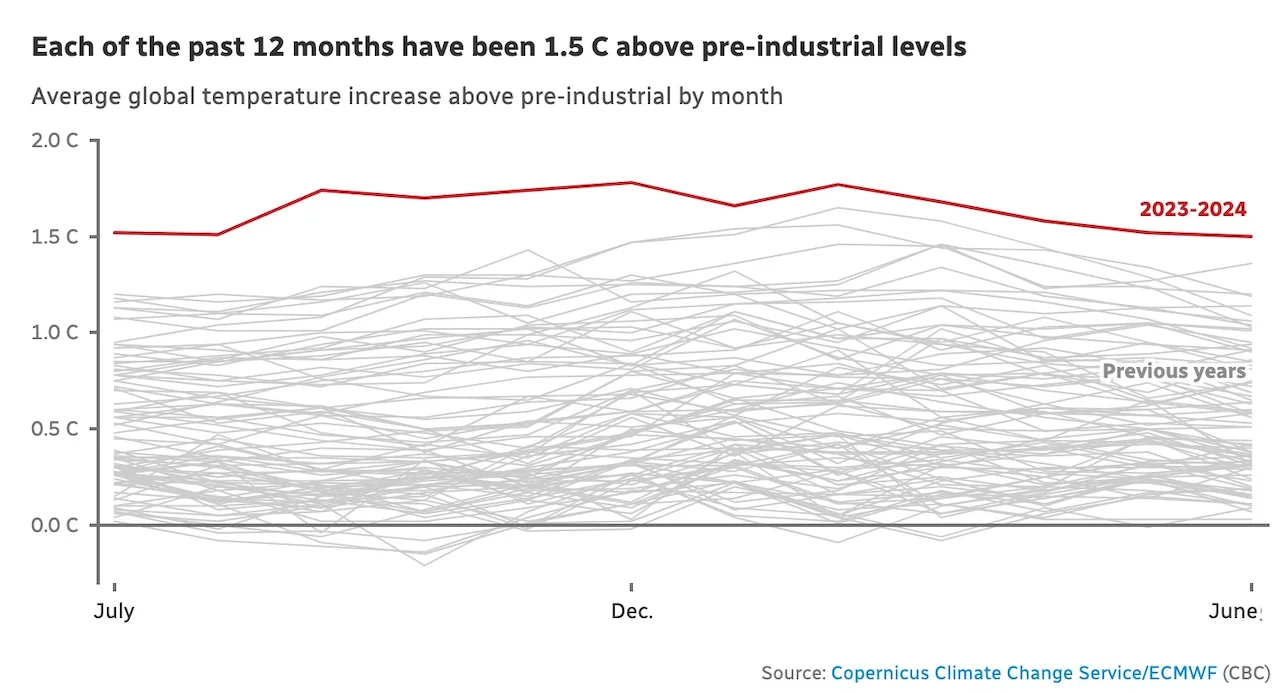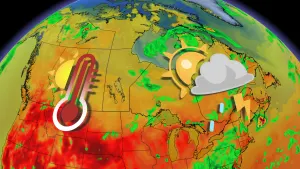
After Earth's year of historic heat, how close are we to passing 1.5 C limit?
While the last 12-month period globally reached 1.64 C above pre-industrial levels, according to the latest data from the Copernicus climate research program, that isn't quite the same as breaching the 1.5 C limit set in the 2015 Paris Agreement.
But it's a major alarm that we're close, and that global warming has continued to speed up in the past few years.
SEE ALSO: Summer Games organizers vow their 'greenest' affair to combat heat
Each month from July 2023 to June 2024 was the hottest on record for that month, and each one reached or crossed 1.5 C above that month's pre-industrial average, the European program said.
The warming is driven in part by the natural El Niño weather pattern, which typically raises temperatures. But the underlying trend of global warming is clear and experts are pointing to factors in addition to greenhouse gas emissions that may have pushed temperatures to the current record levels.
More than greenhouse gases to blame?
Zeke Hausfather, a scientist with Berkeley Earth, a non-profit that works on data analysis for climate science, says the temperature rise is in line with what their climate models predict and the acceleration of global warming being seen over the past 15 years.

(Andrew Kurjata/CBC News)
"It is a pretty dire sign that the world will soon exceed the 1.5 C target, and that we have effectively waited too late to reduce emissions to avoid it," he said in an email.
"The recent 12-month period above 1.5 C is also in line with an apparent recent acceleration in the rate of warming which is in line with what our climate models expect in a world where planet-cooling aerosol emissions (e.g. of sulfur dioxide) are being rapidly reduced while emissions of CO2 and other greenhouse gases remain at record high levels."
Those aerosol emissions refer to air pollutants from things like burning coal and shipping fuel. New regulations have reduced the emissions of these pollutants — which are harmful to human health, but also reflect heat and have a cooling effect on the atmosphere.
Reducing their emissions, some models are suggesting, could be having a warming effect.
The magnitude of heat in 2023 has scientists looking more seriously at the impact of removing these aerosols from the atmosphere — and the long-term impact on climate change, according to Bill Merryfield, a climate scientist at Environment and Climate Change Canada.

(Copernicus Climate Change Service/ECMWF (CBC))
"2023 was so extraordinary that there's been a lot of speculation that there may have been effects on top of the greenhouse gas driving of global warming," said Merryfield, referring to the impact of the new fuel regulations.
"The magnitude of the effect is still being studied and debated. Some scientists think it's very small, some think it may be significant," Merryfield said.
How is this different from the Paris threshold?
The alarming statistics further point to a climate system teetering on the edge, with the impacts of that warming being seen in climate disasters like storms, floods and extreme heat hitting countries around the world, experts say.
But those impacts don't reflect what it actually means to cross the 1.5 C threshold of the Paris climate accord, which refers to a more long-term shift in average temperatures.
"Crossing 1.5 C for 12 months is not the same as crossing the threshold year after year in a global average sense," said Stanford University climate scientist Rob Jackson. "It's different for ice melt, it's different for all kinds of processes."

(Getty Images)
Jackson's upcoming book, Into the Clear Blue Sky, talks about climate solutions and the urgent need to repair the damage to the atmosphere.
"It's surprising and discouraging to be so close to crossing the 1.5 C threshold," he said. "We've sprinted right to the edge of that threshold quickly and quite cavalierly."
Beyond extreme weather, pushing global average temperatures past 1.5 C would have serious impacts on sea-level rise, and could possibly start triggering climate tipping points, such as the irreversible melt of the Arctic permafrost or a change in major ocean currents that regulate global weather.
These major impacts would not be seen if only a few years temporarily crossed the 1.5 C threshold.
According to the World Meteorological Organization, 2023 was the warmest year on record, and there's an 80 per cent chance that at least one of the years between 2024 and 2028 will exceed 1.5 C.
Back in 2015, the chance of this was close to zero, according to the WMO.
WATCH: Heat concern ahead of Paris 2024; could future summer Olympics be at risk?
Thumbnail courtesy of Getty Images/Coffeekai.
The story was originally written by Inayat Singh and published for CBC News.










